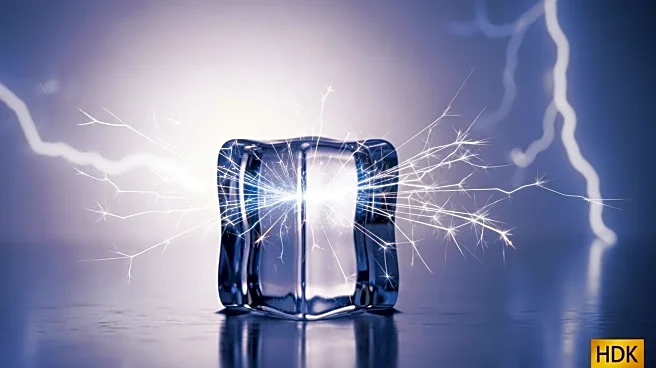What is the story about?
What's Happening?
Recent research has revealed that ordinary ice possesses flexoelectric properties, meaning it can generate electricity when deformed. This discovery, published in Nature Physics, suggests that ice can become ferroelectric at very low temperatures, which could help explain natural phenomena like lightning. The study, involving institutions such as ICN2, Xi'an Jiaotong University, and Stony Brook University, found that ice generates electric charge in response to mechanical stress at all temperatures. A thin 'ferroelectric' layer at the surface of ice at temperatures below -113°C was identified, indicating that ice may have multiple ways to generate electricity. This property places ice on par with electroceramic materials used in advanced technologies.
Why It's Important?
The discovery of ice's flexoelectric properties could have significant implications for both natural phenomena and technological advancements. Understanding how ice generates electricity could provide insights into the electrification of clouds during thunderstorms, potentially explaining the origin of lightning. Additionally, this property could inspire new technologies that utilize ice as an active material, particularly in cold environments. The ability to harness ice's electrical properties could lead to innovative applications in electronics, sensors, and capacitors, expanding the potential uses of this abundant natural resource.
What's Next?
Researchers are exploring new lines of investigation to exploit these properties of ice for real-world applications. While it is still early to discuss specific solutions, the discovery could pave the way for the development of electronic devices that use ice as an active material. Future studies may focus on fabricating these devices directly in cold environments, leveraging ice's unique properties for technological advancements.
Beyond the Headlines
The study's findings suggest that flexoelectricity could be a possible explanation for the generation of electric potential leading to lightning during storms. This challenges previous assumptions about ice's role in cloud electrification and opens new avenues for research into atmospheric phenomena. The discovery also highlights the potential for ice to be used in sustainable technologies, contributing to efforts to reduce reliance on traditional materials and promote environmental conservation.
AI Generated Content
Do you find this article useful?















